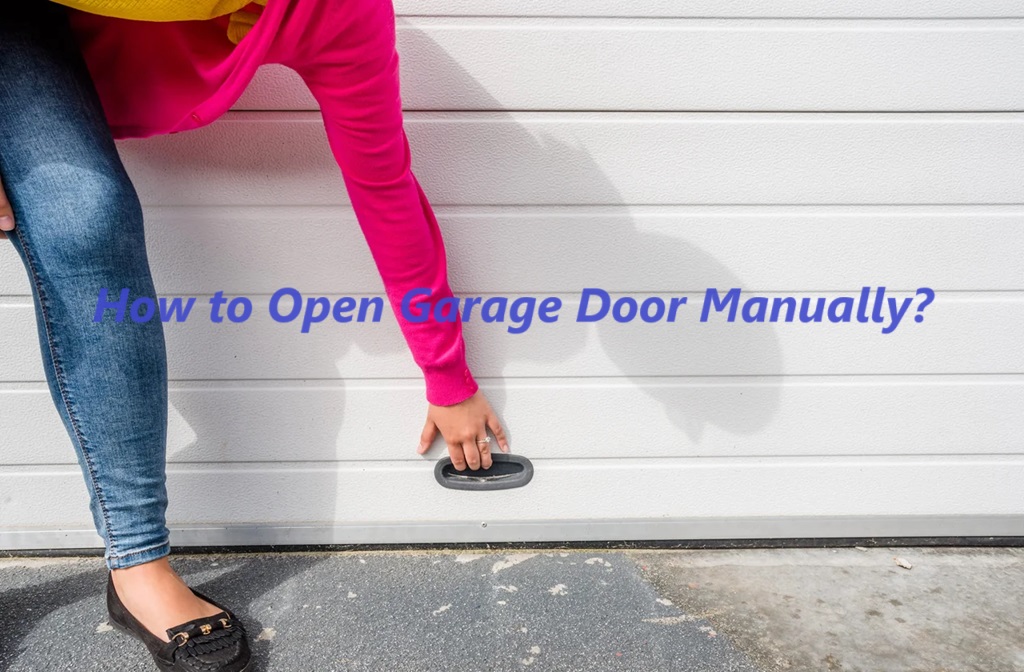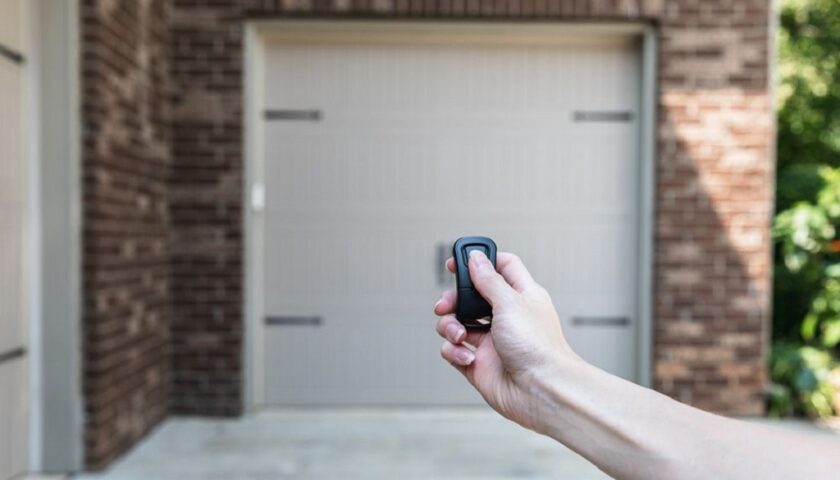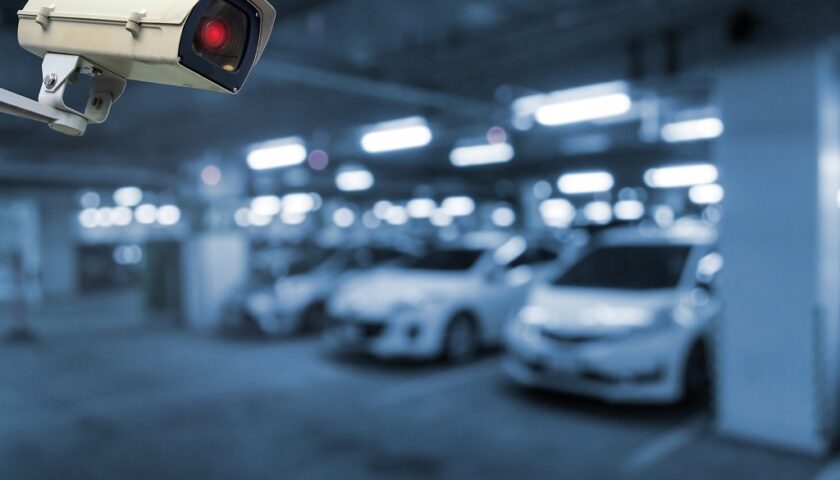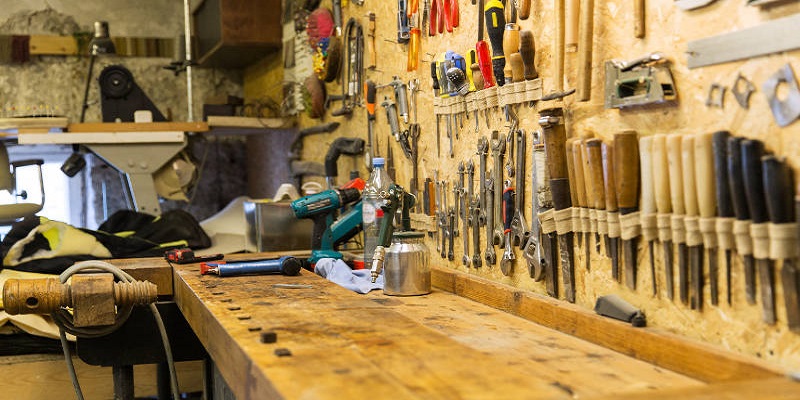Having a garage door that won’t open can be incredibly frustrating. You’re running late for work, need to get your car out to run errands, or are simply trying to get into your garage, and the door won’t budge. While some garage door problems require calling a professional, there are times when you can get the door open yourself manually. Knowing how to open garage door manually. This can save you time and money when issues pop up.
Why Your Garage Door Won’t Open
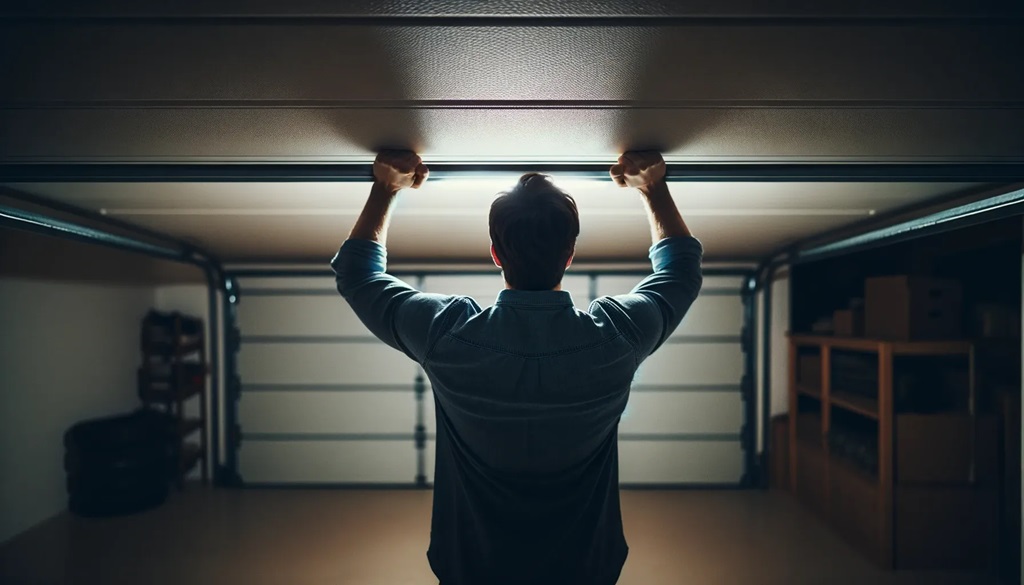
Before we dive into the steps for manually opening your garage door, let’s first look at some of the common reasons why garage doors fail to open in the first place:
Power Failure
Many garage doors today are powered by electricity. The motor and mechanism that opens and closes the door run off the electrical system. If you lose power to your home, such as during a storm or blackout, this can prevent your garage door from opening. Without power, the motor won’t activate to lift the door.
Broken Spring
The springs on your garage door play a critical role. They are under high tension and help counterbalance the weight of the door. This allows the door to open and close smoothly. However, springs can wear out over time and eventually break. A broken spring prevents the door from opening properly.
Obstructed Sensors
Garage doors have safety sensors that detect objects in the path of the door. If something is blocking the sensor beam, it will cause the door to stop or reverse to avoid hitting whatever is underneath it. If these sensors get knocked out of alignment or obstructed in some way, it can stop the garage door from closing or opening.
Bent Track
The metal tracks that guide your garage door as it opens and closes need to be straight and properly aligned. If the track gets bent or misaligned in some way, usually due to impact or accident, it can cause the rollers to get stuck and prevent smooth operation.
Frozen In Cold Weather
In very cold temperatures, the rubber seal along the bottom of your garage door can freeze to the ground. The ice and cold can also impact the rollers and tracks. This can prevent the door from opening until the ice thaws.
Mechanical Failure
The cables, pulleys, bearings, rollers and other hardware on your garage door system can wear out or break over time. Mechanical failure of any of these components can stop the door from moving properly.
Now that we’ve covered reasons why your garage door may not be opening, let’s look at ways to get it open manually.
Preparing to Open Your Garage Door Manually
Before you attempt to open your garage door manually, there are a few important steps to take:
- Disconnect the Opener: If your garage door has an automatic opener, you’ll want to start by disconnecting it. There should be a manual release tether or lever somewhere along the track system. This disconnects the door from the opener so you can move it manually.
- Check for Obstructions: Verify that there are no obstructions in the path of the door. Move any items or debris away from the tracks and surrounding area. You want a clear space to avoid anything hindering the door as you open it.
- Test the Door: Does the door open smoothly about 1-2 feet when you manually lift it? If not, there could be significant mechanical failure or spring issues, which should be addressed by a professional.
- Gather Help: You’ll need some extra hands to raise the door manually. A standard single garage door can easily weigh over 150 pounds. Get 1-2 physically able helpers to assist you in lifting the door.
- Get Proper Gear: Wear sturdy gloves to protect your hands when lifting the door. Soft-soled shoes with traction can prevent slipping. Low-clearance vehicles parked inside may require an additional car jack or lever system to safely lift the door high enough.
Once you’ve completed these preparatory steps, you’re ready to start manually opening the garage door.
Methods to Open Your Garage Door Manually
There are a few different techniques you can use to get your garage door open manually when the power or motor fails. Here are some of the most common methods:
Method 1 – Lifting the Door Manually
The most straightforward way to open your door is for two or more people to simply lift it by hand. Here’s the process:
- Make sure the door is disconnected from any automatic opener.
- Position helpers on each side of the door to lift together. Assign one person as the coordinator to instruct everyone.
- Squat down with legs shoulder-width apart and knees bent in an athletic stance. Keep your back straight.
- Grip under the door panel about shoulder-width apart. Wear gloves for a secure grip and to avoid hand injuries.
- On the coordinator’s mark, work together to lift the door straight up at a steady pace. Avoid jerky motions to prevent back strain or losing grip.
- Raise the door just high enough for vehicles or people to pass under it, ideally to about waist height. Lifting too high can make the door hard to control.
- To lower the door back down, reverse the lifting procedure slowly and gently to avoid slamming or uncontrolled lowering.
- If vehicles need to exit the garage, be sure helpers are out of the path of the door to avoid injury.
This manual lift technique requires physical strength and coordination. Don’t attempt to lift beyond your abilities. Use multiple helpers and proper form to avoid back and hand injuries.
Method 2 – Using a Jack or Lever
If you can’t lift the garage door manually, or need to raise it higher for clearance, you can use a lever system. This allows you to apply the force multiplying properties of levers to open the door with less physical effort.
Here’s how to employ this method:
- Position a car jack or solid wooden beam under the center of the garage door. A 6-8 foot 4×4 lumber post works well.
- Place a flat 2×4 piece of lumber on the ground so it’s positioned under the jack or beam you placed under the door. This will act as your lever.
- Raise the jack manually or pump it using the handle. As you do this, the beam under the door will press up against the closed door and force it open.
- To apply even more force, have helpers press down on the lever board you positioned under the jack/beam. Carefully jump or stomp on the lever to propel the beam upwards against the door.
- Once fully raised, immediately position a sturdy prop or stack of bricks under the door to hold it open until you can disengage any broken opener parts.
- To lower, remove the prop or bricks and slowly release the jack so the door settles back into place gently. Keep hands and feet clear while lowering!
This jack technique allows you to turn the short lifting force of the jack into considerable upward force against the door. Use caution to avoid crushing hands or feet.
Method 3 – Using Vehicle Lift Points
Some garage doors have lift points along the bottom panel where you can insert a specialized emergency release bar. This allows you to hook ratchet winches or vehicle tow straps into the lift points to crank the door open.
If your garage door doesn’t have factory lift points, you may be able to loop straps or chains through openings in the bottom panel hardware to lift it.
Here are the basic steps for this vehicle-assisted method:
- Check your garage door for factory lift point openings along the bottom panel. If none exist, look for openings in the hardware that straps or chains can loop through securely.
- Attach a solid tow strap, chain, or winch system to a lift point or through an opening. Make sure it’s secured and won’t slip out when lifted.
- Thread the strap through an opening on both sides of the door so the force is balanced. Attach to a truck, SUV, or other vehicle.
- Carefully operate the vehicle to apply upward tension to the straps/chains. Go slowly to avoid sudden force.
- Raise the door just enough for entry or to disengage automatic openers before releasing tension.
- Lower the door gently using the vehicle to relieve tension slowly and keep control.
Use extreme care with this method to avoid vehicle damage or the door releasing in an uncontrolled manner. Never exceed door or vehicle lifting ratings.
Troubleshooting Problems During Manual Lifting
As you go through the process of manually opening your stuck garage door, here are some problems you may encounter and how to address them:
Door feels too heavy or unbalanced: Get additional helpers to share the load. Reposition helpers to lift evenly. Inspect door and hardware for any broken springs, cables or points of mechanical failure.
Rollers won’t move in track: Apply WD-40 or similar lubricant to roller and track. Check for warped/misaligned tracks and bend back into shape if possible. If hardware is damaged, replacement may be required.
Door binds at certain points during lift: Inspect to see if door is rubbing the tracks or any support hardware as it lifts. Try gently lifting past the sticking point. Determine if adjustment or replacement of mounts is needed.
Bottom panel hits the floor: Fully disconnect any panel seal material stuck to the floor. Raise door higher to clear the seal. Check for panel or hardware damage. Insert wooden blocks under the door as temporary spacers if needed.
Vehicles or objects obstruct lifting path: Ensure you have helpers lifting high enough for adequate clearance. Use car jacks or wooden beams to lift door above obstructions as needed. Remove any vehicles or items blocking the path.
Difficulty aligning tracks when lowering: Go slow when bringing the door back down. Have helpers support the door and guide the rollers into the track rather than just letting go. Watch and realign as needed.
No factory lift points on door: Use excess strap/chain length looped through hardware openings rather than hooks. Choose points that can withstand door weight without bending or popping open.
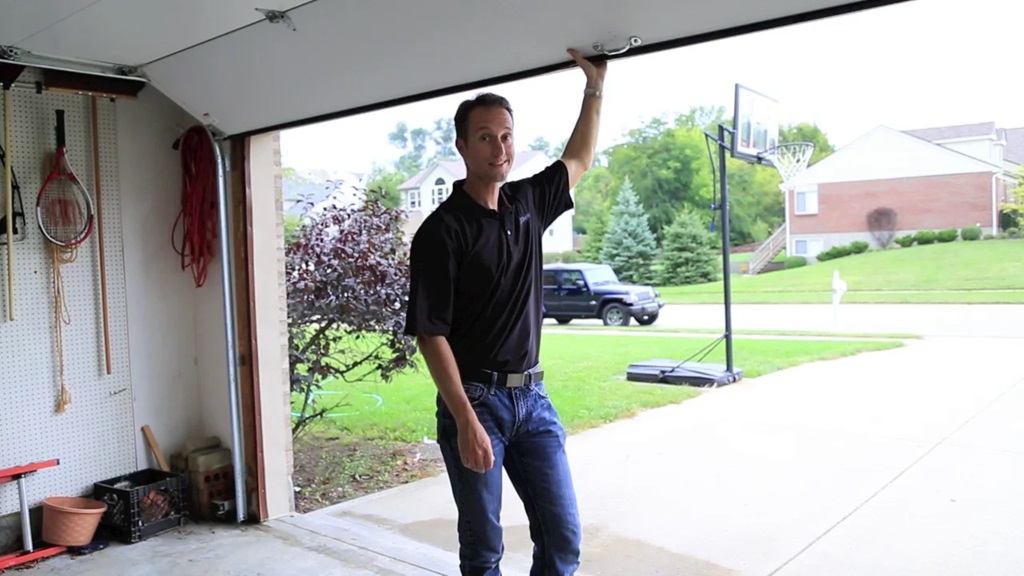
When to Call a Garage Door Technician
While the door opening methods above can get your garage accessible in a pinch, be aware that manually lifting a stuck garage door is only a temporary solution in most cases. It’s important to understand when the problem requires calling in a professional:
- If the door doesn’t operate properly even after manual lifting, there is likely a mechanical issue that needs repair.
- Any broken springs, cables, rollers, pulleys or hardware will require replacement by a pro.
- Doors that bind, tilt, or jump the track during manual operation likely need realignment and adjustment by a technician.
- If the door is severely unbalanced or overly difficult to lift manually, springs may be broken and need replacing.
- Damage to the door panels themselves often requires professional help to fix properly.
- Any issues with electric openers will need diagnosis and servicing beyond basic disconnecting.
- If you can’t determine why the door failed to open, a technician can assess the situation and identify the underlying problem.
Temporary manual lifting can get your vehicles or items out of the garage. But for continued, reliable operation, have a qualified garage door technician inspect and fix any ongoing issues.
Preventing Future Garage Door Problems
To help minimize garage door issues down the road:
- Keep The Tracks Clean – Check the tracks periodically and wipe away any dirt, debris, grit, leaves or grease that can impede the rollers.
- Lubricate The Tracks And Hardware – Apply garage door lubricant to tracks, rollers, pulleys and any bearings at least once per year. This prevents rust and reduces friction.
- Check For Loose Hardware – Inspect supports, brackets, hinges and fasteners. Tighten any loose screws, nuts or bolts that could vibrate loose over time.
- Test The Reversal System – Run safety tests on electric garage door openers per manufacturer instructions. Adjust beam sensors as needed.
- Listen For Noises – Take note of any grinding, clacking, squeaking or unusual sounds as the door operates. Identify and fix the source early before serious damage occurs.
- Consider a Professional Inspection – Have a qualified garage door pro conduct periodic tune-ups and look for signs of premature wear, alignment issues or functional problems.
Following these preventive maintenance tips can help maximize garage door lifespan and avert unexpected functional failures from happening at the most inconvenient times.
Being able to manually open your garage door is invaluable in an emergency situation or power outage. Evaluate your physical abilities and recruit helpers as needed for safe lifting. Also consider installation of an emergency release system if one doesn’t already exist for your door. Just be sure to address any underlying mechanical problems promptly to avoid continued malfunctions down the line.
FAQs
- How much force does it take to manually lift a garage door?
On average, a standard 7-foot high single garage door weighs between 150-220 lbs. But the required lifting force can exceed 300 lbs for some large or high-end doors. Having 2-4 people share the load is recommended.
- Can manually lifting my garage door cause damage?
If done properly, manually lifting should not cause damage. Ensure the door tracks are straight, panels aligned, and hardware intact. Lifting doors in a jerky manner that over-stresses components can cause problems over time.
- Is WD-40 safe for garage door tracks and rollers?
Yes, WD-40 works well for lubricating garage door parts to improve function. Avoid overspray on plastic components. Wipe off excess lubricant and reapply a thin coat every 6 months.
- Can I replace garage door springs myself?
Replacing tension springs is complex and potentially dangerous if not done properly. Unless you have professional experience, it’s safest to have a certified garage door contractor handle spring replacement.
- How do I realign a garage door track that’s come loose?
Check for loose track bracket bolts first and re-tighten securely. For minor alignment issues, tap the track gently with a rubber mallet to realign. Avoid bending the track too far out of shape. Call a pro for major alignment or hardware issues.
In Conclusion
Dealing with a stuck garage door can certainly be frustrating. But in many cases, arming yourself with some helpful information and an extra set of hands means you can get the door operable again temporarily. Just be sure to thoroughly inspect the door, use proper lifting techniques, and keep safety top of mind.
Knowing when to call in a professional garage door repair company is also important. Ensure the longevity of your garage springs by incorporating professional assistance. How to maintain your garage springs: They have the expertise to properly diagnose and fix any mechanical or structural problems that routine manual lifting won’t address. Keep their contact information handy as part of your regular garage maintenance plan.
With some preparation and effort, you can get your garage door open manually when issues arise. Just take the proper precautions to avoid injury or creating additional problems. And consider it an opportunity to assess if your garage door needs some TLC and upgrading! Maintaining everything in good working order makes life much simpler when you need quick access.

